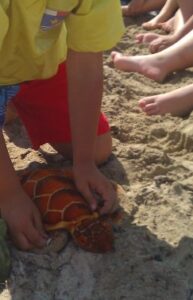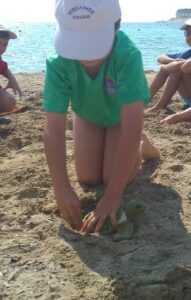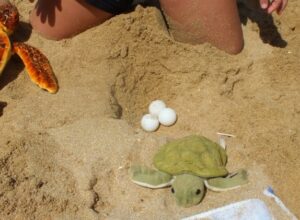BeMED 8. A Turtle’s Life
Title |
A Turtle’s Life |
||
Author |
Esther Sammut Carbone |
||
Age Guide |
Year 2–6 |
||
Subject Area |
Social Studies, Science |
||
| Preparation Time | Viewing and discussing the 3 video clips (links provided): 45 minutes
Optional – Making cardboard turtles or origami: 30 minutes |
||
| Estimated Duration | 2 hours in total
Introduction: 30 minutes; Development: 55 minutes; Conclusion: 30 minutes. |
||
| Site | On a sandy beach | ||
| Educational objectives | To understand that marine litter affects wildlife, through the lifecycle of a turtle and the threats it encounters until it reaches maturity and beyond.
To understand that marine litter affects us and future generations through its durability, spreading and accumulation in food chains. To raise awareness of the nature and magnitude of the marine litter matters with reference to the dominance of land based sources of marine litter, dominance of plastic among the marine litter items, the top ten items in marine litter, the lifetime of different waste materials especially plastic objects, the micro-plastics issue and sources, the 5 garbage patches, the spread of litter from source countries. To understand that action is needed by everyone in everyday life to tackle the marine litter matters. To identify some of these actions with emphasis on daily waste minimisation efforts besides wildlife rescues and to encourage to start taking action. |
||
| Learning Outcomes | – I can recognise the relationship between understanding others and the wellbeing of all in the present and the future.
– I can identify the root causes of inequality and injustice and actions that lead to a better quality of life, equity, solidarity and environmental sustainability. – I can use the natural, social and built environment that surrounds me, as a context and source of learning. – I can involve myself and others in real-world issues to bring about a positive difference. – I can reflect upon the consequences of my actions on present and future generations. – I can live in harmony with myself, others and the natural world at a range of levels from the local to the global. – I can identify the root causes of inequality and injustice and actions that lead to a better quality of life, equity, solidarity and environmental sustainability. – I can use the natural, social and built environment that surrounds me, as a context and source of learning. – I can involve myself and others in real-world issues to bring about a positive difference. – I can reflect upon the consequences of my actions on present and future generations. – I can live in harmony with myself, others and the natural world at a range of levels from the local to the global. Yr 2: – Identify practical ways of reducing, reusing, recycling, and repairing waste as well as refusing items and rethinking everyday practices to safeguard planet Earth. – Ask questions about the environment around them. – Work individually and in groups, share and discuss ideas and listen to other ideas Make connections to everyday life situations Yr 3-6: – I can ask questions about the world around me. – I can explain the importance of the 4Rs: reduce, reuse, recycle and repair. – I can ask questions about the world around me. – I can classify materials as natural or man-made. – I can find out about the effects human intervention can have on natural habitats and the organisms that live there. – Discover that things are manufactured using materials. – Know that the environment is a system which can be harmed. – Know that some materials occur naturally, and others do not. – Identify the main problems related to waste management and suggesting sustainable solutions. |
||
| Link to SDGs | SDG 3: Good Health and well-being
SDG 14: Life below water |
||
| Educational resources required | For role play, per small group: a turtle soft toy and 7 table tennis balls.
Appendix 8.1 & 8.2: Quiz questions and accompanying visual aids – Yr2-3/ Older students with learning difficulties. Appendix 8.3 & 8.4: Quiz questions and accompanying visual aids – Yr4–5/ Older students with learning difficulties Appendix 8.5 & 8.6: Quiz questions and accompanying visual aids – Yr6 / Younger Gifted Students (to print Appendices 8.2 or 8.4 or 8.6 according to student abilities, if it is not possible to show on screen) Appendix 8.7: Questions for the Introductory Brainstorming Appendix 8.8: Questions for the Preparatory Circle Time Appendix 8.9: Turtle Craft and Turtle Origami Appendix 8.10: Choice of news (as additional resources for quiz) Appendix 8.11: Background information Internet connection |
||
| Remote preparation | a) View the following video clips and follow with circle time to raise the points specified in the objectives through questioning that faciliate discussion (Appendix 8.8).
· 3 Minute Into My Turtle Journey (a turtle life cycle presented as a story). https://www.facebook.com/Naturee.jellysmack/videos/1038397429881010 · Il-Ħajja fil-Baħar u Jien · https://www.facebook.com/1453654901539856/videos/2373918726234898 and/or Marine Life and Me (features marine wildlife rescues, connection of wildlife casualties to waste, some waste facts and numbers, need for action). https://www.facebook.com/1453654901539856/videos/182362609839413 · What does the inside of a turtle’s mouth look like? (to understand why waste is highly dangerous for turtles). https://www.youtube.com/watch?v=xOBbkLltlgE b) Recommended especially with older students: Viewing Appendix 8.10 – presentation “A Choice of News – Issues & Acitons” for a mind-set towards taking action. c) Optional/ needed if opting to “hatch turtles” for correct answers (instead of replacing eggs in the nest) during the quiz: EITHER make a turtle craft OR a turtle origami from a used paper or magazine sheet (as in Appendix 8.9). |
||
| Planning Considerations | Tips:
Group size recommended – one class divided into smaller groups of up to 5 students. Keep the number of small groups up to 4 unless the class is larger than 20. Things to bring with them: a beach towel to dry and clean their feet from sand before boarding back on the coach or minibus; caps, sunblock, packed lunch and drinking water.
For info about the app: https://oceanconservancy.org/trash-free-seas/international-coastal-cleanup/ Download a simple How-To-Use Clean Swell poster here. Safety: Have a portable first aid kit with you. Give clear instructions before the activity and repeat once on site, about: – the boundary up to where they can roam around during the whole activity including breaks – you can mark with traffic cones. – the limit up to where they can go down into the sea if you are allowing them to wet their feet, e.g., up to their knees. Instruct clearly to remove the shorts, shoes, and socks according to the set limits. – picking up any waste safely if you are to allow it – provide gloves or hand-pickers and ask to get your permission before doing so. – to never throw sand at each other and handle sand with caution while playing during breaks especially if it is windy.
Common misconceptions: Recycling confused with reducing and reusing. For instance, making crafts from used material is an example of reusing not recycling. Recycling is the primary solution to solve waste management issues – NOT TRUE. Avoiding production of waste should always be the top priority. That’s why waste reduction is higher than recycling in the 4Rs hierarchy. Waste has decomposed completely if it is no longer visible – NOT TRUE. Mussels are an example in which microscopic micro-plastics accumulate by filter feeding. The best way to help injured wildlife is to provide first aid yourself – NOT TRUE. Our intervention can cause further injury unintentionally. For example, if we pull a fishing line out of a turtle’s mouth, there might be the fishing hook inside and this tears the gut. Always call Wildlife Rescue Team and wait till they arrive. Number: 99999505. |
||
| Method | Introduction
Role play: turtle laying eggs (15 minutes) · Class is split into 2 or more groups. A turtle soft toy is given to each group. A representative from each group uses the soft toy to imitate a turtle coming up on the beach to lay eggs. While they are crawling, digging and laying eggs, brainstorm turtle fact by questioning (Appendix 8.7) · The chosen student makes the soft toy turtle crawl up from the water edge pushing the sand using its flippers, digging the hole using the soft toys’ flippers and gets the soft toy turtle ready in a position to lay eggs. Another student quickly places table tennis balls under the soft toy and uses the fingers to roll the balls one be one into the hole. The turtle covers the balls using its hind flippers and moves back towards the sea.
· Each student in the group (including the student who was moving the soft toy) pretends to be a ghost crab, comes moving sideways and steal the eggs (they take at least one each) from the nest. Development Quiz and saving eggs/hatchlings (40 minutes) Having several groups will require the presence of two or more adults. It is advisable to carry out the activity as a whole class if not enough adult assistants are available. This will also limit the possibility of materials getting lost in the sand. Refer to the appendices for the quiz questions. Have a print-out of the presentation “Quiz visual aids Yr2-3 / Yr4–5/ Yr6” to show with respective questions. · The quiz starts. Each small group answers questions in turns. For each correct answer an egg is saved – the ghost crabs put the eggs back in the hole in turns. · If all available eggs/hatchlings of a group are used up, a student from the group is given a picture of a hatchling to wear around the neck, stands next to the group’s nest and and for correct answer makes a step forward towards the sea. Alternatively, for each correct answer: · For correct answers, eggs are laid by the turtle – omit the ghost crabs part from the introductory role play. · For correct answer, eggs are hatched – omit the ghost crab part from the introductory role play. Instead, hide baby turtle toys in the sand after the turtle covers the nest, and a student from each group is chosen to push up a hatchling out of the sand for each correct answer. (If baby turtle toys are not available they can use cardboard or origami turtles prepared in class before the activity.) · For wrong answers, eggs / hatchlings – omit the ghost crab part from the introductory role play and have eggs/hatchlings caught by ghost crabs, birds or large fish (pictures worn around the neck help them to get into the role). Conclusion · The winning team is awarded a symbolic certificate of wildlife rescuers per student. · Gather the class sitting down on the sand in a circle and ask them to think about one action they would like to take to prevent litter from entering the oceans. Encourage them to share it with the class. |
||
| Follow-up activities | Optional, in class after the activity:
Wordsearches for further familiarisation with the marine wildlife literacy. Pledging and/or making a promise to the Blue Planet Earth, and following the commitment. Pledge example: “I pledge to start using cloth bags and refuse plastic bags offered at shops.” |
||
| Background information for educators | Appendix 8.11
|
||
| Adaptations | For students with learning difficulties:
§ Use the quiz version in Appendix 8.1. § Opt for the cardboard Turtle Craft if “hatching turtles” for correct answers. § Refer to the links for the Wordsearches, gradually increasing in difficulty level respectively: https://www.educaplay.com/learning-resources/5826309-under_the_sea.htmarine litter https://www.educaplay.com/learning-resources/5827210-under_the_sea.htmarine litter |
||
| Extensions | For gifted students:
§ Use the quiz version in Appendix 8.5. § Opt for the turtle origami craft if “hatching turtles” for correct answers. § Refer to the links for the Wordsearches, gradually increasing in difficulty level respectively: https://www.educaplay.com/learning-resources/5826477-life_below_water_juniors.htmarine litter https://www.educaplay.com/learning-resources/5826675-life_below_water_juniors_adv.htmarine litter
|
||
 Download Clean Swell app from google play and create an account as instructed. By the end of the activity it is likely that they start spotting waste they were not aware of earlier and are eager to collect it to the point it is difficult to convince them to stop. Consider a longer stay to include a short beach clean-up and upload waste data in the Clean Swell app by Ocean Conservancy.
Download Clean Swell app from google play and create an account as instructed. By the end of the activity it is likely that they start spotting waste they were not aware of earlier and are eager to collect it to the point it is difficult to convince them to stop. Consider a longer stay to include a short beach clean-up and upload waste data in the Clean Swell app by Ocean Conservancy.






